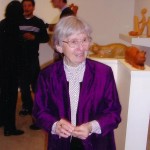
Keyser carved wood steadily from her late teen years until she was 82 yeas old, when, getting ready for an exhibition, she put down her tools and never picked them up again. At the time, she was unaware that she was developing Parkinson’s disease. She describes the cessation of her work as being, “like somebody took a faucet and turned it off.” Today she speaks movingly about her dedication to sculpture. “I loved it with a passion. Why else would you do something so difficult? I would tell young artists to become a sculptor only if you will die if you don’t do it. That’s how I felt.”
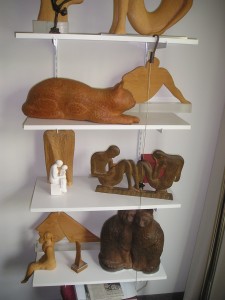
Keyser vividly recalls working in the sculpture studio at Tyler School of Art on her first day and realizing that direct carving, “just felt right.” When she and her twin sister Elsie Manville graduated, Evelyn took the carving tools and Elsie took the easel. Manville is now a noted realist painter and Evelyn is an acclaimed sculptor of what she describes as “representational” works.
Keyser’s parents, who emigrated from the area between Poland and Russia, moved from South Philadelphia to Broad and Olney after she and her sister started at Tyler. She recalls that her parents, “Didn’t think much of artists, they would have preferred a doctor, a lawyer, or a druggist. But we promised them we’d get a teaching degree.” Although she enjoyed painting, there was something more physical and tangible in sculpture, or as she puts it, “painting is an illusion and sculpture is real.”
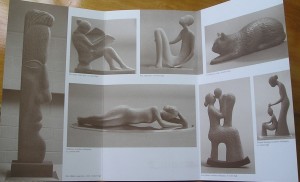
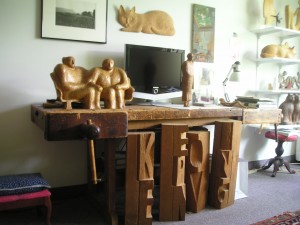
Many of Keyser’s public commissions were in conjunction with building projects by the architect Norman Rice, whom she remembers fondly as a “truly brilliant” man. See the Moon, 1964, was cast in bronze and sits outside of the Free Library at Broad and Morris streets. A massive work, it shows a mother and child looking up to the sky in a shared reverie. She began exploring the theme of mothers and children after her daughter was born in the late 1940s; she also has a son. Another important work, The Reading Bench, shows a mother reading to a child and is in the Kathryn Drexel branch of the Free Library. Made of teak, Keyser describes the ease and joy of this project as though it was, “like putting a penny in the slot machine and having all the marbles fall out.” Occasionally Keyser visited this sculpture to see how the wood aged because “wood gets prettier and prettier as it gets older.” Her favorite wood is Honduras Mahogany, “the hardest of the soft woods.”
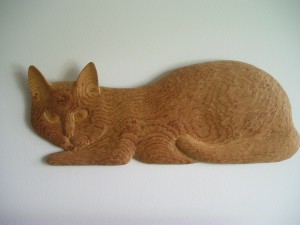
Keyser was married for twenty-nine years to a fellow artist, the painter Gerson Keyser, who she says, “supported us with his golden right hand.” She notes that “only one year did I earn more than he did.” The Keysers commissioned Norman Rice to build their house, which is a noted example of mid-century modern building in Philadelphia. Keyser describes Philadelphia in the 1960s, 70s and 80s as a great place to make a life as an artist: “Exhibits were open to artists every year at PAFA and the Whitney, it was a very lively arts community, Ed Sozanski stared writing and he was very critical, the 17th street galleries were important, the Woodmere became a museum. There were opportunities. We couldn’t do it now.” She describes her family life with “Gus” in a deeply moving way and with great love. “We were two artists, we were working comrades, we were lovers. You have to be careful because eventually all artists compete. Marriage is work, and if you are two artists you have to work even harder.”
When asked what it was like to be a woman in the decidedly man’s world of direct carving, she says that she “felt lucky, even though the world of commissions is also a man’s world.” Keyser found one way to circumvent some of this discrimination by always signing her work and professional correspondence with her first initial only, hiding her gendered first name.
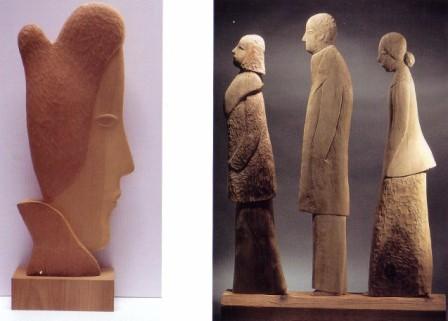
Keyser graduated from art school during a time when wood carving in the United States was thriving. The work of William Zorach and Elie Nadelman secured this popularity. Keyser, however, cites Ossip Zadkine as an “inspiring” influence. She also liked the early work of Henry Moore for a while. Her own work is representational, but simplified. It’s abstracted in the way that Etruscan or Egyptian sculpture is — broadly descriptive but with great economy, like poetry. Late in life Keyser started carving cats, and the wood she chose to do so suggests their soft fur. She is fond of work that hangs on the wall, free from the traditional relief support, or work that can sit, unaided, on the edge of a shelf. The contemporary sculptors she admires include Arlene Love and Steven Robin. Much of her work reflects family life – mothers and children, couples and family groups. She notes that she particularly liked to carve twosomes, saying that “the reason for that is obvious.”
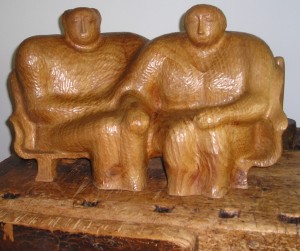
Keyser now lives in an apartment in Rydal, PA surrounded by some of her work, pictures of her great-grandchildren, and her magnificent carving bench on which she produced over three-hundred sculptures. She exhibited with Gallery Joe until 2003, and in 1985, the Woodmere Art Museum had a fifteen-year retrospective of her work.





